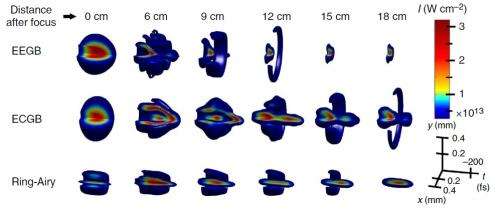November 12, 2013 feature
Scientists create light bullets for high-intensity optical applications

(Phys.org) —Controlling the propagation of high-intensity light beams as they travel through air (or other transparent media) is a challenging task, but scientists have now shown that a relatively new type of light beam called a ring-Airy beam can self-focus into intense light bullets that propagate over extended distances. These well-defined, high-intensity optical wavepackets could have applications in a variety of areas, such as laser micromachining and harmonic generation.
The scientists, P. Panagiotopoulos, D.G. Papazoglou, A. Couairon and S. Tzortzakis, from institutions in Greece and France, have published a paper in a recent issue of Nature Communications in which they show theoretically and experimentally how ring-Airy beams transform into light bullets.
An airy beam is a type of light beam that has the distinct feature of forming a parabolic arc as it propagates through space. In fact, it gets its name from the Airy integral, developed in the 1830s by Sir George Biddell Airy to describe the way light bends in a rainbow.
In 2011, scientists (including some of the authors of the current paper) experimentally demonstrated an Airy beam in the shape of a ring. In the linear regime, this ring-Airy beam can focus itself into a sharp focal point, which could make it an ideal candidate for precise laser ablation applications in hard-to-reach environments.
In the new study, the scientists have investigated the properties of ring-Airy beams in the non-linear regime, and found them to be even more impressive than in the linear regime. The scientists found that the ring-Airy wavepacket reshapes itself into a propagating high intensity light bullet that spreads neither in space nor in time over significantly longer distances than Gaussian beams, which are often used in conventional lasers.
The researchers also found that, when the input power is increased, the ring-Airy beam's focus position is not shifted nearly as much as it is for Gaussian beams. The researchers could mathematically predict the position of the ring-Airy beam's focus for a given input power, which they confirmed through experiments.
These highly focused, high-intensity ring-Airy beam light bullets offer a very high level of control that cannot be achieved with equivalent Gaussian beams, making them ideal for a variety of optical applications ranging from precision materials processing to attosecond drivers.
More information: P. Panagiotopoulos, et al. "Sharply autofocused ring-Airy beams transforming into non-linear intense light bullets." Nature Communications. DOI: 10.1038/ncomms3622
Journal information: Nature Communications
© 2013 Phys.org. All rights reserved.



















